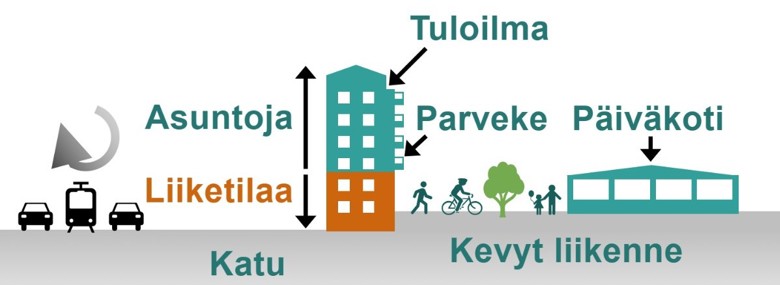Placement of functions is used to reduce exposure to air pollutants

Block structure planning and protective functions
In busy environments, exposure to traffic emissions can be reduced through planning. The block structure has an impact on the dilution of traffic emissions. An enclosed block made up of apartment buildings or a long, continuous string of buildings lining the street reduce the dispersion of air pollutants to the building’s courtyard or residence areas. However, it must be ensured in the planning that the air quality limit values are not exceeded on the street side. The exposure of pedestrians and cyclists can be reduced by building light traffic routes within block areas, further away from traffic.
Exposure to air pollutants can also be reduced by placing protective buildings or functions between the route and housing. For example, office buildings, parking facilities and areas, walled carports, outbuildings, lot fences and planted areas can act as a buffer, protecting residences and residence areas from traffic emissions.
Planning of individual buildings
In the planning of residential buildings, balconies and residence yards should be placed on the sheltered side of the buildings along busy streets and roads. The lowest floors are better suited for purposes other than housing. Apartments extending through the building allow ventilation from the quieter and more sheltered side of the building. It is recommended that bedrooms and living rooms be placed on the sheltered side. Exposure can also be reduced by means of various façade solutions, such as double-skin façades, balcony access corridors, balcony zones and solid façades. In addition to exposure to air pollutants, exposure to traffic noise is also reduced.
The indoor air quality of buildings can be improved by efficient air filtration and by placing the supply air intake as high and as far away as possible from the emission source. The supply air intake must be located away from loading and parking spaces and the exhaust pipes of parking facilities.